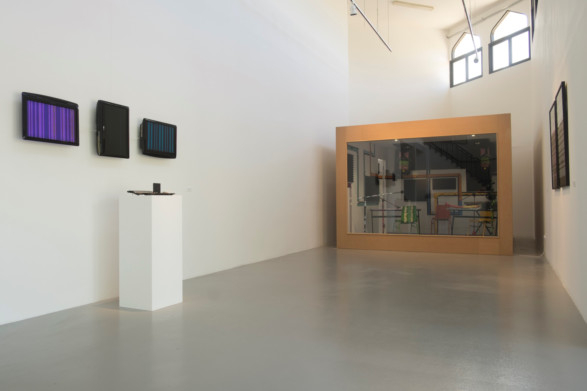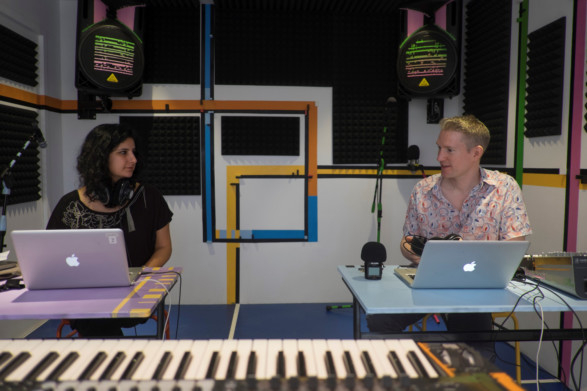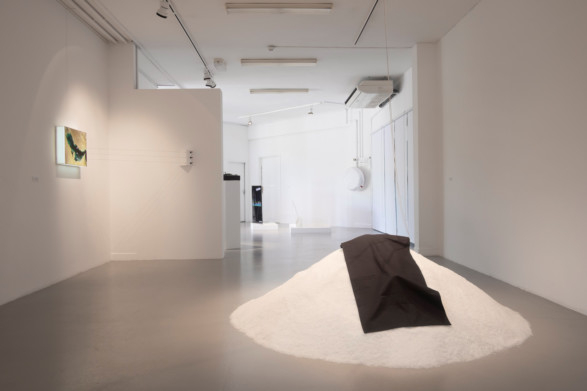
London-based music professionals Fari Bradley and Chris Weaver have been experimenting with sound art for many years. But an art residency at Tashkeel in Dubai has given them the time, freedom and facilities to focus on their art projects and explore new ideas.
In their first solo exhibition in the region, “Systems for a Score”, the artists have used sound as a semantic tool and structuring device to create sculptures and installations that range from singing oil barrels and music inspired by Emirati al sadu weaving to silent pieces that suggest an aural concept or experience in the mind of the viewer.
The centrepiece of the show is a recording studio for collaborative work with artists from the local community. The artworks trigger our innate ability to decode, decipher and extract composition and rhythm from visual and auditory matter, and challenge our understanding of listening as a sensory experience conditioned by context. They explore the use of sound as a medium for delineating the invisible or intangible, while also commenting on cultural and socio-economic issues.
Iran born Bradley is a member of the UK’s independent art-music radio station Resonance 104.4 FM, and promotes experimental and fringe dance genres, and Middle Eastern and North African art and culture through her radio shows. As a composer and improvisational performer, she has created commissioned works for prestigious museums, galleries and art events.
Weaver is a founder member of the electro-acoustic ensemble Oscillatorial Binnage, and has performed with many well-known musicians. He was a production manager at Resonance 104.4 FM and also the director of the station’s radio orchestra. He teaches courses in Sound Art at the London College of Communication and has held workshops on arts-radio, audio hardware hacking and electronics around the world. He was named “Sonic Artist of the Year” in 2013 by the British Academy of Songwriters.
We spoke to the two artists about their work and this show. Excerpts:
What is your perspective on sound art?
FB: I have studied classical western and Indian music and always saw sound and music as a way to release my imagination. But after I learnt to manipulate sound digitally at the radio station, I began to experiment with the idea that noise can also be art. Sound art is about shared listening experiences as opposed to individuals looking at a screen in an increasingly visual world. But it does not necessarily feature sound. In our show there are pieces that are silent, and only conjure sound in the viewer’s mind, thus dealing with sound in a metaphysical way.
CW: As a musician I have spent most of my life making sounds out of things, so my ideas are refracted through sound. I am an artist who thinks primarily in sound, and rather than images or colours, I use acoustics or vibrations. Sound is a new medium, but the grammar and forms of this artistic language are becoming widely accepted as art. From musicians in the 1940s who recorded sounds of nature to experimental musicians of today, artists continue to push the boundaries of this form of art.
What is the significance of the Emirati al sadu weave in this exhibition?
FB: When we began researching this region before starting the residency, we immediately saw the lines and irregularities in the Emirati al sadu weave patterns as data for a score. And we also noticed the similarity with the graphics from a 1980s Atari game console that Chris has. So the correlation between the imperfect knots and stitches in the weave and the glitched Atarai code patterns became a link between the aural and visual aspects of the show. This is highlighted in “Models for a Score”, where three screens display video taken from a physically modified Atari games console with the visual movement and varying orientation generating geometries for sound.
CW: “Systems for a Score” is about finding frameworks to make new music from, and the systems we have chosen are based on the dots, lines and rectangles in the al sadu patterns. The weave reminded us of the old Atari computer games; and we have rearranged that graphic system to use it as the main visual link for the whole show. The patterns are like graphic scores that can be read differently by different people, and it is a strong way to illustrate our endeavour to see and hear things differently.
What other experiments did you do with patterns and technologies of sound making?
FB: In “Drum Circle” the music emanating from a stack of oil barrels is simply the result of harmonisation between their internal tones. The sound sculpture titled “Products” uses a visual language for making sound. Here two whitewashed audio mixers, which we visually associate with sound, are linked by a complex web of wires. No sound is played into them, but the barely audible hum in the electronics is amplified so that the mixers become creators of sound instead of playing their usual role as facilitators for other music scores.
CW: In “Soundtrack Telepathique” we have used cassette boxes — the first home-recordable technology, to explore the inaudible electromagnetic and radio-frequency signals transmitting data into the atmosphere as possible sounds. And the muffled sound from the speakers submerged in salt in “Weight” question the need to visualise sound in current sound art. In “Red Tide” the reach and tonality of the sound emerging from copper wires, originating or boring into the sea on a satellite map of this region, depends on their length, tension and material. The piece explores ideas about geography, ecology, oil spills, mining, red tides, listening and identity.
What is the idea behind ‘A Model Studio’?
FB: It is a recording studio located inside the gallery where we have invited local musicians and artists to come and collaborate with us, while visitors can watch the recording sessions through the glass window. The space and equipment inside has been personalised with banners and stickers featuring al sadu patterns, interpreted through an Atari computer.
The starting point of every recording session is the graphic representation of the al sadu weave. The weaves are read as an abstracted form of music and fed through digital systems to produce sound. Selected recordings will be pressed as limited edition vinyl records. To complete the circle, each vinyl record will come with a piece of handmade weave, rendered from digital patterns of the music. The whole point of the exhibition is to show that just like the al sadu weave can be read as a score, one can make a system for a score or a visual language of music from anything.
CW: This studio is a way to explore how a single idea can be interpreted in different ways with different people. Despite the same starting point the outcomes will be different with every person who records with us.
Jyoti Kalsi is an arts enthusiast based in Dubai.
The show will run at Tashkeel until February 14.














